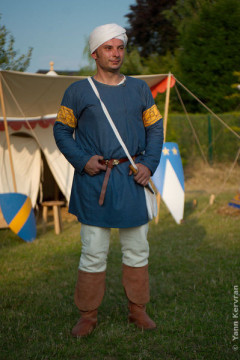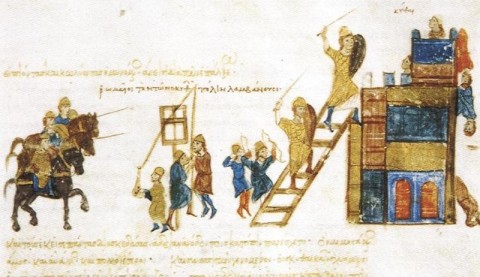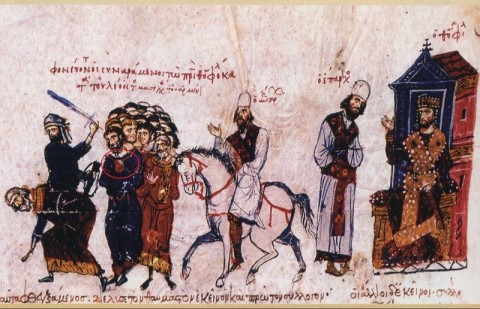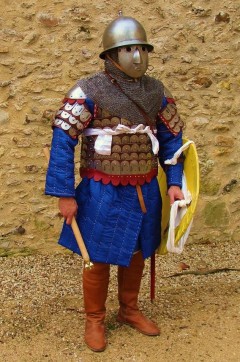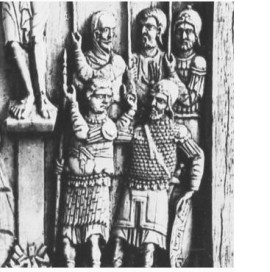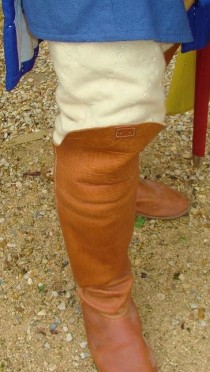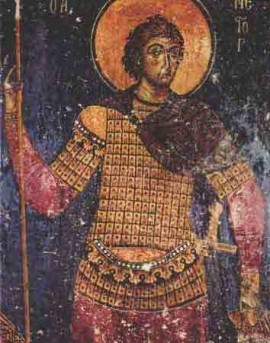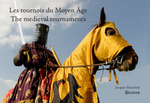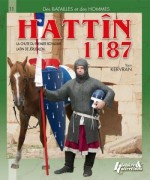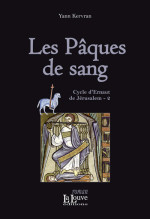Photography : Yann Kervran
- Byzantine heavy infantryman -
by Sebastien H. - Translated by Ivan
Byzantine heavy infantry Kentarkhês (centurion), late 12th century.
This reconstruction is based on sources for the equipment from military treatises, especially from the 10th century (Praecepta Militaria), and on interpretations of pictorial sources from the 12th century which provide information on its evolution. It is also based on clues from chronicle sources, as well as the research of experts in the field. For this reason, this work is an interpretation, and does not claim in any way to be the final word on the subject.
Civilian dress
The civilian costume consists of a silk roukhon (tunic), with a fastened collar. The pattern, as well as the fastening, can be seen on the Skylitzes manuscript. This tunic was probably influenced by Persian fashions. The undergarments consist of a pair of linen periskelisma (breeches), and a pair of touvia (hose) also of linen. The boots (hypodêmata) can be folded down during normal activity or pulled up to cover the knees during combat, providing an adequate level of protection. The turban (fakeolon) is wrapped around a wool skull-cap (which may also be made of felt or leather) and is probably influenced by eastern fashions.
Military dress
This consists of :
- A kavadion : a quilted silk coat with a cotton filling "as thick as can be sewn" with a raised collar. This was the basic protective equipment for infantrymen. The pattern and the opening are a Greek version of the Percian kaftan. The off-centre opening improves protection for the wearer by overlapping the two sides of the coat on the torso. The coat has two vents on the side, rising almost to the waist for ease of walking. This garment is shown on some pictorial sources and is also described in military treatises.
- A pair of kampotouva, a type of footless woollen hose, replacing the touvia.
- A klibanion, or lamellar armour, of the type specific to the Eastern Roman Empire. The scales are riveted onto a leather band, and the bands are hung by laces. The are some doubts the exact method used to fasten the klibanion, since this is not shown in any pictorial sources. I have therefore chosen an opening at the back, fastened by means of buckles. An opening at the side would be another possibility. The infantryman can also wear a pair of manikellia, or armour for the upper arms, made of scales hanging upside down. Protective plates for the shoulder can also be added. Leg armour similar to that used for the upper arms can also be added. This is called a kresmasmata and is also made of inverted scales. The completes armour is shown on the painting of Saint Nestor, who is depicted as an infantryman. Following the sack of Constantinople in 1204, scale armour seems to have disappeared completely among Imperial armies.
- The shield (skoutarion), tear-shaped and 90 cm to 110 cm tall. Military manuals give a precise description. Very few pictorial sources show the leather hanging straps ; in fact they are usually omitted altogether. In this reconstruction, the strap is made of fabric, following Muslim or Armenian practices.
- The helmet is a kind of "eastern kettle-hat". It can be seen on the Skylitzes manuscript, where it is usually worn by Bulgars, as well as Russians and Eastern Romans (or Byzantines). This rounded and pointed form became widespread during the 13th century among the Byzantines, in the Balkans and Russia. It is shown in the 11th century menologium of Basil II.
- The facial mask, influenced by the equipment of steppe peoples, was found among the ruins of the Great Palace in Constantinople and has recently been dated to the 12th century. It was not very comfortable for a footsoldier, except for tight formations, but would have been more useful for cavalrymen. However, it could also have been used by an officer, who had an essential role in commanding and controlling the complex manoeuvres of the tagma on the battlefiel, and would have benefited from extra protection while relaying ordrers.
- Military treatises give precise descriptions of mail armour. The mail had to be made "according to Roman fashion". Mail made of alternating riveted and solid rings is traditionaly attributed to the Roman Empire. This type of mail has been found in various regions under Byzantine influence, or sharing trade links with Byzantinium. The mail hood, covering the face, is made in this way. This kind of hood probably shows some Western influence.
- Offensive weapons include a spathion, a straight double-edged sword with a smal hilt. The sword hangs from baldrick, reminiscent of Roman army equipment, and is shown on a multitude of paintings ans sculptures. The infantryman can also carry a lance, and military manuals describe three types. Here we see a kontarion makron, wich is between 4 and 5 meters long.
The question of the Pektorarion
The band of fabric called the pektoranion is shown on all Byzantine images of warrior saints. Il is wrapped around the torso and knotted at the front. Used during the Roman Empire to indicate officer rank, it survived in Byzantine imagery, but it is not mentioned in any military treatises or chronicle sources. Is this artistic conservatism or convention, or a symbol of sainthood (since it is worn by warrior saints) ? All these hypotheses are possible. Il could also have been used for ceremonial purposes, or by an honour guard, during military triumphal parades or religious processions, where military units often participated. The question remains open.
Bibliography
- Everyday Men's clothing of the eastern roman empire. Timothy Dawson, levantia historical guides
- Byzantine infantryman.Timothy Dawson, Osprey publishing
- Sowing the dragon's teeth. Eric Mcgeer. Dumbarton Oaks
- Arms and armour of the crusading era 1050-1350. David Nicolle. Greenhill books
- Companion to medieval arms and armours. Collection of articles edited by David Nicolle and The Boydell press
- Byzantium at war. John Haldon. Osprey publishing
- Crusader warfare volume1. David Nicolle. Hambledon continuum
- La civilisation byzantine. Louis Bréhier. Albin Michel

